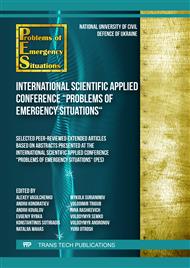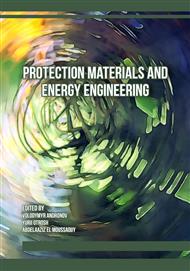[1]
B. Pospelov, V. Andronov, E. Rybka, R. Meleshchenko, S.Gornostal, Analysis of correlation dimensionality of the state of a gas medium at early ignition of materials, Eastern-European Journal of Enterprise Technologies, 5/10 (95) (2018) 25–30.
DOI: 10.15587/1729-4061.2018.142995
Google Scholar
[2]
S. Ragimov, V. Sobyna, S. Vambol, V. Vambol, A. Feshchenko, A. Zakora, E. Strejekurov, V. Shalomov, Physical modelling of changes in the energy impact on a worker taking into account high-temperature radiation, Journal of Achievements in Materials and Manufacturing Engineering, 91(1) (2018) 27–33.
DOI: 10.5604/01.3001.0012.9654
Google Scholar
[3]
A.N. Semko, M.V. Beskrovnaya, S.A. Vinogradov, I.N. Hritsina, N.I. Yagudina, The usage of high speed impulse liquid jets for putting out gas blowouts, Journal of Theoretical and Applied Mechanics, 52(3) (2014) 655–664.
Google Scholar
[4]
Y. Abramov, O. Basmanov, J. Salamov, A. Mikhayluk, Model of thermal effect of fire within a dike on the oil tank, Naukovyi Visnyk Natsionalnoho Hirnychoho Universytetu, 2 (2018) 95–100.
DOI: 10.29202/nvngu/2018-2/12
Google Scholar
[5]
K. Korytchenko, O. Sakun, D. Dubinin, Y. Khilko, E. Slepuzhnikov, A. Nikorchuk, I. Tsebriuk, Experimental investigation of the fire-extinguishing system with a gas-detonation charge for fluid acceleration Eastern-European Journal of Enterprise Technologies, 3/5 (93) (2018) 47–54.
DOI: 10.15587/1729-4061.2018.134193
Google Scholar
[6]
P.J. Wakelyn, Environmentally friendly flame resistant textiles, Advances in Fire Retardant Materials Woodhead Publishing Series in Textiles, (2008) 188–212.
DOI: 10.1533/9781845694701.1.188
Google Scholar
[7]
C.K. Kundu, L. Song , Y. Hu, Chitosan-metal oxide nanoparticle hybrids in developing bi-functional polyamide 66 textiles with enhanced flame retardancy and wettability, Applied Surface Science Advances, 7 (2022) 100202.
DOI: 10.1016/j.apsadv.2021.100202
Google Scholar
[8]
S. Vambol, V. Vambol, O. Kondratenko, Y. Suchikova, O. Hurenko, Assessment of improvement of ecological safety of power plants by arranging the system of pollutant neutralization, Eastern-European Journal of Enterprise Technologies, 3/10 (87) (2017) 63–73.
DOI: 10.15587/1729-4061.2017.102314
Google Scholar
[9]
O. Rybalova, S. Artemiev, M. Sarapina, B. Tsymbal, A. Bakhareva, O. Shestopalov, O. Filenko, Development of methods for estimating the environmental risk of degradation of the surface water state, Eastern-European Journal of Enterprise Technologies, 2/10 (92) (2018) 4–17.
DOI: 10.15587/1729-4061.2018.127829
Google Scholar
[10]
A. Chernukha, A. Teslenko, P. Kovaliov, O. Bezuglov, Mathematical modeling of fire-proof efficiency of coatings based on silicate composition, Materials Science Forum, 1006 (2020) 70–75.
DOI: 10.4028/www.scientific.net/msf.1006.70
Google Scholar
[11]
O. Skorodumova, O. Tarakhno, O. Chebotaryova, Y. Hapon, F. M. Emen, Formation of fire retardant properties in elastic silica coatings for textile materials, Materials Science Forum, 1006 (2020) 25–31.
DOI: 10.4028/www.scientific.net/msf.1006.25
Google Scholar
[12]
N. Didane, S. Giraud, E. Devaux, Fire performances comparison of back coating and melt spinning approaches for PET covering textiles, Polymer Degradation and Stability, 97 (2012) 1083–1089.
DOI: 10.1016/j.polymdegradstab.2012.04.010
Google Scholar
[13]
A. Keshavarzian, M. N. Haghighi, F. A. Taromi, H. Abedini, Phosphorus-based flame retardant poly (butylene terephthalate): Synthesis, flame retardancy and thermal behavior, Polymer Degradation and Stability, 180 (2020) 109310.
DOI: 10.1016/j.polymdegradstab.2020.109310
Google Scholar
[14]
C. K. Kundu, C. Sekhar, R. Gangireddy, L. Song, Y. Hu, Flame retardant treatments for polyamide 66 textiles: Analysis the Role of Phosphorus compounds, Polymer Degradation and Stability, 182 (2020) 109376.
DOI: 10.1016/j.polymdegradstab.2020.109376
Google Scholar
[15]
E. Gibertini, F. Carosio, K. Aykanat, A. Accogli, G. Panzeri, L. Magagnin, Silica-encapsulated red phosphorus for flame retardant treatment on textile, Surfaces and Interfaces, 25 (2021) 101252.
DOI: 10.1016/j.surfin.2021.101252
Google Scholar
[16]
S. Wang, L. Du, P. Zhu, Z. Jiang, Influence of hydroxyl-terminated phosphoramidates on the flame retardancy of microfiber synthetic leather, Polymer Degradation and Stability, 199 (2022) 109897.
DOI: 10.1016/j.polymdegradstab.2022.109897
Google Scholar
[17]
M.E. Hall, A.R. Horrocks, J Zhang, The flammability of polyacrylonitrile and its copolymers, Polymer Degradation and Stability, 44 (1994) 379–386.
DOI: 10.1016/0141-3910(94)90097-3
Google Scholar
[18]
N.K. Kim, D. Bhattacharyya, Development of fire resistant wool polymer composites: Mechanical performance and fire simulation with design perspectives, Materials & Design, 106 (2016) 391–403.
DOI: 10.1016/j.matdes.2016.06.005
Google Scholar
[19]
J. Alongi, C. Colleoni, G. Rosace, G. Malucelli, Sol–gel derived architectures for enhancing cotton flame retardancy: Effect of pure and phosphorus-doped silica phases, Polymer Degradation and Stability, 99 (2014) 92–98.
DOI: 10.1016/j.polymdegradstab.2013.11.020
Google Scholar
[20]
I. Borisenko, O. Burmenko, N. Deyneko, O. Zobenko, Y. Yivzhenko, G. Kamyshentsev, V. Muraviov, Yu. Mykhailovska, V. Khrystych, S. Kryvonis, Development of a method for producing effective cds/cdte/cu/au solar elements on a flexible substrate designed for backup supplying systems prevention of emergency situations, Eastern-European Journal of Enterprise Technologies, 6/5 (114) (2021) 6–11.
DOI: 10.15587/1729-4061.2021.247720
Google Scholar
[21]
R. Olawoyin, Nanotechnology: The future of fire safety, Safety Science, 110 (2018) 214–221.
DOI: 10.1016/j.ssci.2018.08.016
Google Scholar
[22]
J. Wang, J. He, L. Ma, Y. Zhang, L.Shen, S. Xiong, K. Li, M. Qu, Multifunctional conductive cellulose fabric with flexibility, superamphiphobicity and flame-retardancy for all-weather wearable smart electronic textiles and high-temperature warning device, Chemical Engineering Journal, 390 (2020) 124508.
DOI: 10.1016/j.cej.2020.124508
Google Scholar
[23]
J. Alongi, F. Carosio, G. Malucelli, Current emerging techniques to impart flame retardancy to fabrics: An overview, Polymer Degradation and Stability, 106 (2014) 138–149.
DOI: 10.1016/j.polymdegradstab.2013.07.012
Google Scholar
[24]
S. Nehra, S. Hanumansetty, E.A. O'Rear, J.B. Dahiya, Enhancement in flame retardancy of cotton fabric by using surfactant–aided polymerization, Polymer Degradation and Stability, 109 (2014) 137–146.
DOI: 10.1016/j.polymdegradstab.2014.07.002
Google Scholar
[25]
A. Sharshanov, O. Tarakhno, A. M. Babayev, O. Skorodumova, Mathematical Modeling of the Protective Effect of Ethyl Silicate Gel Coating on Textile Materials under Conditions of Constant or Dynamic Thermal Exposure, Key Engineering Materials, 927 (2022) 77–86.
DOI: 10.4028/p-8t33rc
Google Scholar
[26]
A. Chernukha, A. Chernukha, P. Kovalov, A. Savchenko, Thermodynamic study of fireprotective material, Materials Science Forum. 1038 (2021) 486–491.
DOI: 10.4028/www.scientific.net/msf.1038.486
Google Scholar
[27]
A. Chernukha, A. Chernukha, K. Ostapov, T. Kurska, Investigation of the processes of formation of a fire retardant coating, Materials Science Forum, 1038 (2021) 480–485.
DOI: 10.4028/www.scientific.net/msf.1038.480
Google Scholar
[28]
O.B. Skorodumova, G.D. Semchenko, Y.N. Goncharenko, V.S. Тolstoi, Crystallization of SiO2 from ethylsilicate-based gels, Glass and Ceramics, 58(1–2) (2001) 31–33.
DOI: 10.1023/a:1010933028152
Google Scholar
[29]
O. Skorodumova, O. Tarakhno, O. Chebotaryova, Improving the Fire-Retardant Properties of Cotton-Containing Textile Materials through the Use of Organo-Inorganic SiO2 Sols, Key Engineering Materials, 927 (2022) 63–68.
DOI: 10.4028/p-jbv49r
Google Scholar
[30]
O. Skorodumova, O. Tarakhno, O. Chebotaryova, O. Bezuglov, F .M. Emen, The use of sol-gel method for obtaining fire-resistant elastic coatings on cotton fabrics, Materials Science Forum, 1038 (2021) 468–479.
DOI: 10.4028/www.scientific.net/msf.1038.468
Google Scholar
[31]
V. Andronov, Y. Danchenko, Y. Makarov, T. Obizhenko, Colloid-chemical regularities of reagent wastewater treatment of dairies, Materials Science Forum, 1038 (2021) 235–241.
DOI: 10.4028/www.scientific.net/msf.1038.235
Google Scholar
[32]
V. Loboichenko, V. Andronov, V. Strelets, O. Oliinykov, M. Romaniak, Study of the State of Water Bodies Located within Kharkiv City (Ukraine), Asian Journal of Water, Environment and Pollution, 17(2) (2020) 15–21.
DOI: 10.3233/ajw200015
Google Scholar
[33]
Y. Hapon, M. Chyrkina, D. Tregubov, O. Romanova, Co-Мo-W galvanochemical alloy application as cathode material in the industrial wastewater treatment processes, Materials Science Forum, 1038 (2021) 251–257.
DOI: 10.4028/www.scientific.net/msf.1038.251
Google Scholar
[34]
B. Pospelov, E. Rybka, R. Meleshchenko, S. Gornostal, S. Shcherbak, Results of experimental research into correlations between hazardous factors of ignition of materials in premises, Eastern-European Journal of Enterprise Technologies, 6(10) (2017) 50–56.
DOI: 10.15587/1729-4061.2017.117789
Google Scholar



